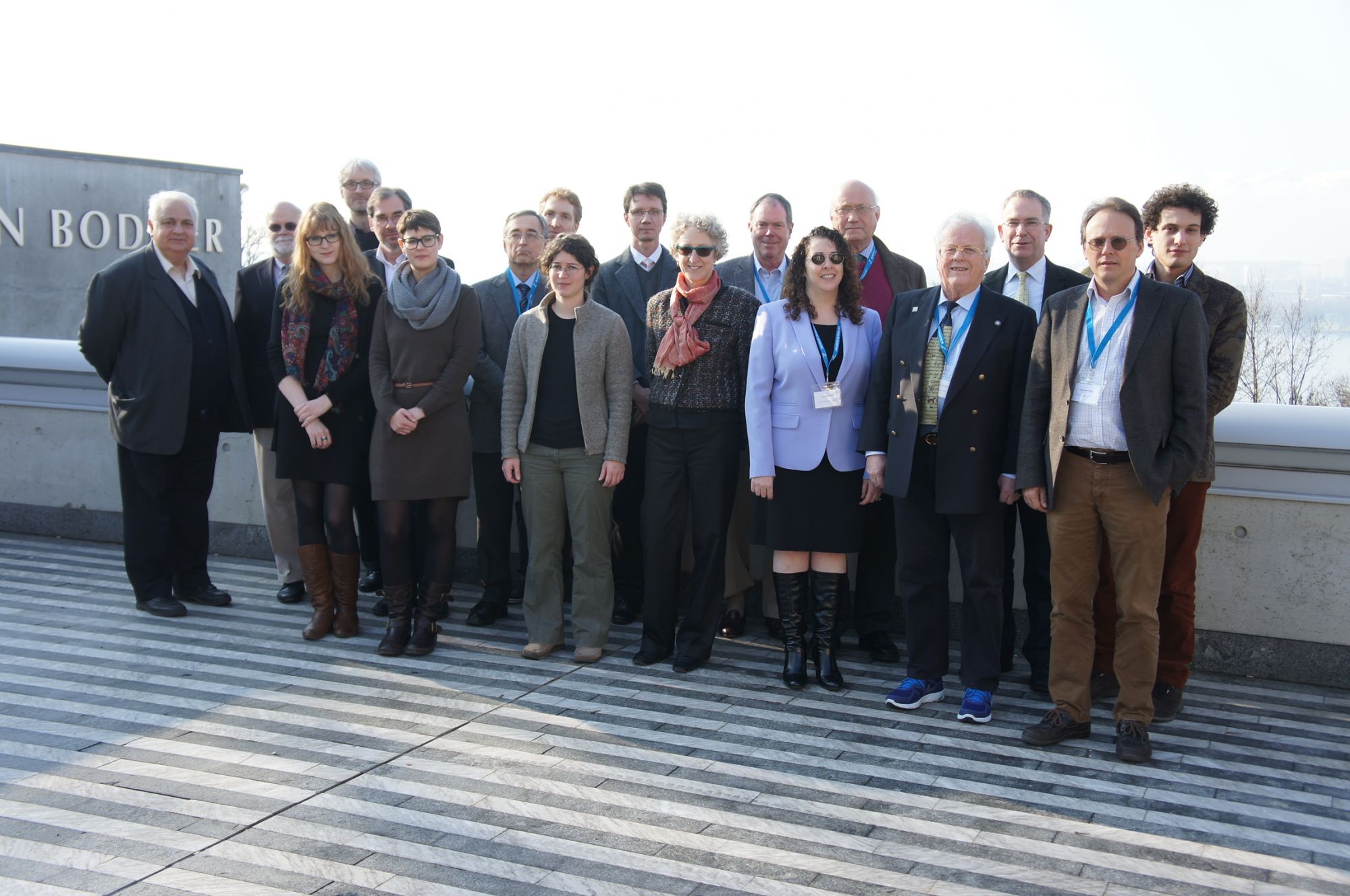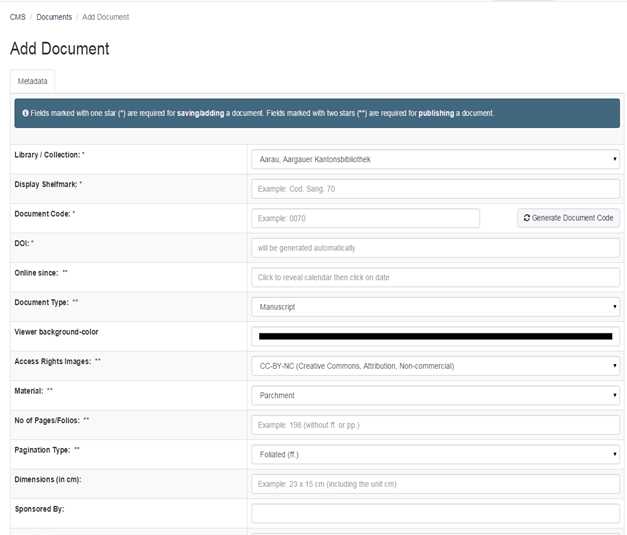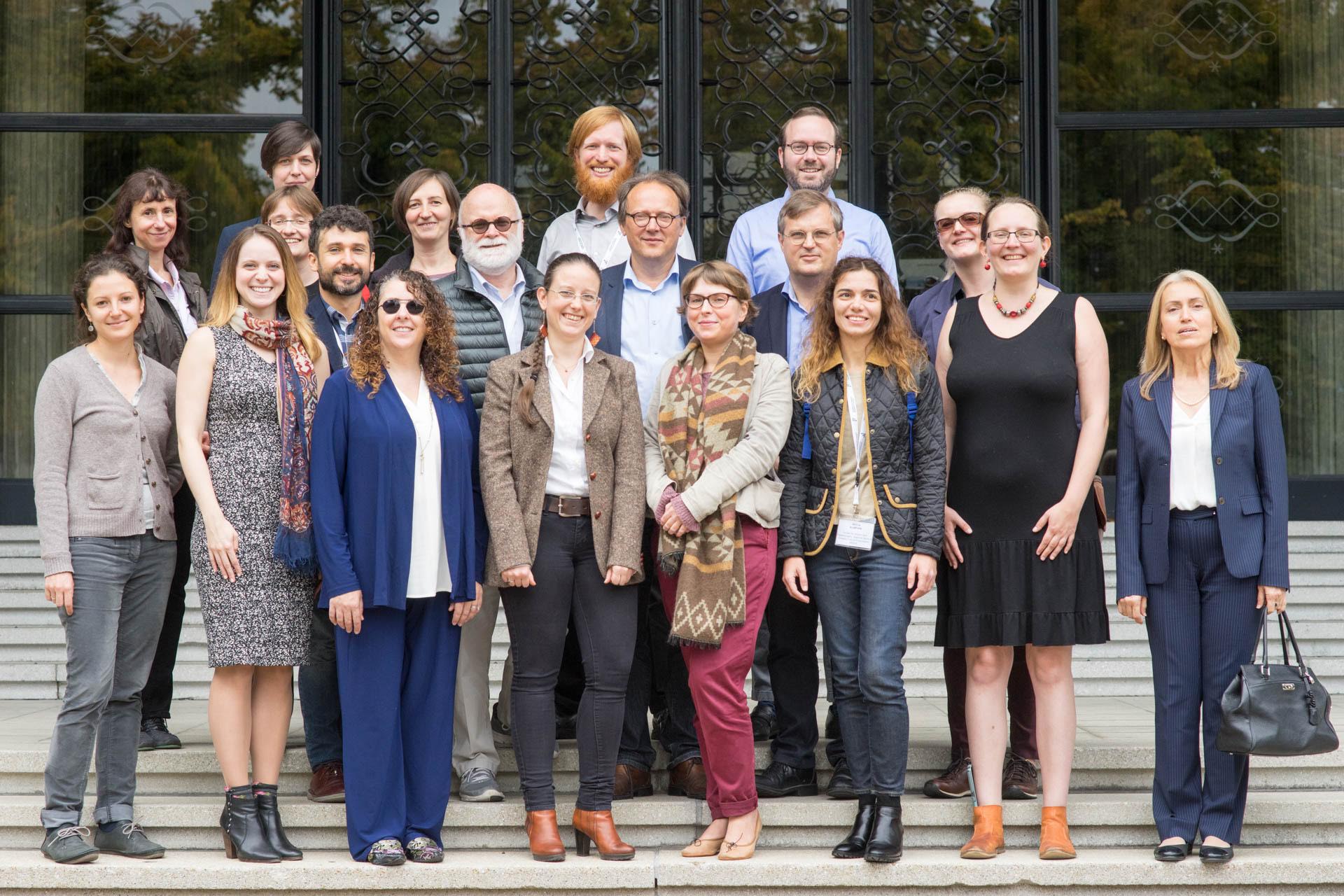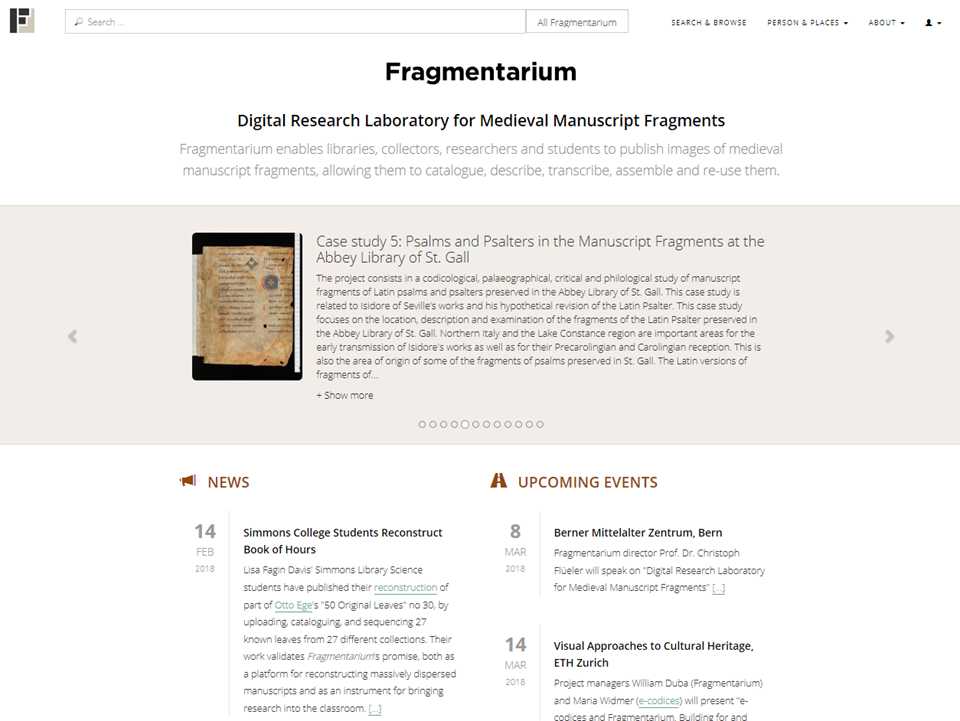Past and Present
Fragmentarium's Timeline
2013, 22 February |
Start of the Fragmentarium Pre-project |
2014, 30 January-
|
Planning Meeting I, Geneva and Cologny |
2015, January 1 |
Beginning of Fragmentarium Phase I |
2015, 1 June-
|
Swiss National Science Foundation Project #156569: Fragmentarium |
2016, 7-8 June |
Ex parte enim cognoscimus. 1st Case Study Workshop, University of Fribourg |
2016-
|
Case Studies 1-6 |
2017, 31 May-
|
2nd Case Study Workshop, Herzog August Bibliothek, Wolfenbüttel |
2017-
|
Case Studies 7-12 |
2017, 30 August-
|
Planning Meeting II and 3rd Case Study Workshop, Stiftsbibliothek St. Gallen |
2017, 1 September |
Fragmentarium Laboratory Launches with 379 documents |
2018, 5-6 October |
Bits and Pieces. Medieval Manuscript Fragments in the Digital Age. 4th Case Study Workshop, University of Fribourg |
2018, December |
First issue of Fragmentology published |
2018, December 31 |
End of Phase 1: Fragmentarium has published 761 documents |
2019, January 1-
|
Swiss National Science Foundation Project #182173: Fragmentarium Phase II |
2019, 1 August |
Launch of Stavros Niarchos Foundation sub-project: Retracing the Past: Writing and History in the Fragments of the Bibliothèque nationale de France. |
2019, 26-28 August |
First Fragmentarium Cataloguing Course, University of Fribourg |
2019, 24 September |
1000 documents published on Fragmentarium |
2019, December |
Second issue of Fragmentology published |
2020, January-
|
Fragmentarium 2020 Fellowships, with support from the Zeno Karl Schindler Foundation |
2020, 29 May |
New Front End Design Launched |
2023, August |
5000 documents published on Fragmentarium |
Project Planning (2013-2014)
The Project Fragmentarium started with a core intuition, namely that digital technologies can allow large-scale cataloguing of medieval manuscript fragments and make fragment research a distinct field of manuscript studies, based fundamentally on methods developed by digital libraries and digital humanities. Yet, along with this intuition came an observation: when librarians, collectors, and scholars speak of fragments, they often refer to very different objects. The first research questions therefore were: what fragments are there, and how have scholars been studying them?
To answer these questions, Prof. Christoph Flüeler, director of e-codices, organized a meeting in Geneva and Cologny at the end of January 2014 for a small group of manuscript researchers, librarians, and collectors together with specialists in Digital Humanities. The idea of an international digital library for manuscript fragments took flesh: build a platform, based on e-codices, that uses the latest in interoperable technologies to enable institutions, small and large, as well as individuals to describe, publish, and analyze medieval manuscript fragments.

Fragmentarium Planning Meeting, 31 January 2014
The support and interest generated at the Planning Meeting provide the impetus necessary to make the project a reality.
Phase 1 (2015-2018)
With the support of the Swiss National Science Foundation, the Stavros Niarchos Foundation, and the Zeno Karl Schindler Foundation, Fragmentarium began as a project on 1 June 2015. The first phase of the project had three tasks:
- Build a Web Application
- Coordinate International Research Projects
- Develop an International Network
Building a Web Application
Fragmentarium grew out of e-codices, and this relationship provided it with a head start: a dynamic, modular, and state-of-the-art codebase for a digital library that was designed, developed, tested, and optimized over twelve years. Yet the Web Application had to break new ground. For one, the international and massively collaborative aspect of the project required a new model of interoperability, one that, at the start of the project, did not exist. Fragmentarium, along with e-codices and Stanford University Library became the first users of IIIF, the International Image Interoperability Framework. Through IIIF, Fragmentarium not only makes its images available to other websites, it brings in images from other institutions. Second, as research objects, fragments had to be treated differently from manuscript books, and the information that scholars wanted and could provide needed to be determined. Indeed, Fragmentarium is a laboratory at heart, and treats as research problems seemingly simple questions such as “How best to display images of a fragment?” and “What elements should there there be in a fragment description?"

Prototype of Basic Metadata Page, 2015
Coordinating International Research Projects
To address these needs, Fragmentarium drew upon its research resources. Besides the Fragmentarium platform itself, the major research project conducted in house is the Ph.D. dissertation of Mag. Mag. Veronika Drescher, – A Fragmented Library. Reconstruction of the Medieval Holdings of the Abbey of Saint-Père-en-Vallée”. To show the broad potential of fragment studies, Fragmentarium complemented this in-house research with a case study model. It allied with its partner institutions to identify twelve significant fragment projects and to pair them with external researchers (fellows), typically early-career scholars, who work under the guidance of experienced specialists (supervisors). These case studies were divided into two seasons: 2016-2017 and 2017-2018, with six case studies in each season. This research not only resulted in the publication of fragments and descriptions, as well as articles in the journal Fragmentology, it also helped establish the parameters of the Web Application; the case studies focused on types of fragments, and the Web Application could be adapted to support best those fragments.

Participants at the Fragmentarium Workshop "Bits and Pieces", 2018
Developing an International Network
Academic disciplines are built on networks of peers. Fragmentarium brought together early career researchers, senior scholars, librarians, and digital humanists for workshops where they would share information on their research and develop strategies for analyzing fragments. The project established partnerships with sixteen founding partners, who have been actively engaged in the project, hosting case studies, sponsoring digitization and fellowships, lending expertise, and even securing funding for allied projects.
The high point of Phase I was undoubtedly the launch of Fragmentarium on 1 September, 2017, an event that took place during the Fragmentarium Second Planning Meeting hosted by the Abbey Library of St. Gall. As the Web Application was opened to the public, the researchers working on case studies presented their results, and the representatives of partner institutions shared their expertise on the future of Fragmentarium.

The “Launch Version” of the Fragmentarium Front Page
Phase 2 (2019-2021)
Phase 2 turned Fragmentarium from a pilot project into an essential node of fragment studies with regards to digitization, research, and teaching. It provides the global fragment community the resources to gather data on fragments, publish images and descriptions of them, conduct research on them, and form a cadre of researchers capable of continuing the discipline.
To support research, Fellowships continued the case-study model from Phase 1. In addition, Fragmentarium collaborated (and still collaborates with) with several multi-year research projects that involve fragments. It published (and publishes) annually in Open Access Fragmentology, the first and only journal dedicated to medieval manuscript fragments. As a Swiss research project, moreover, Fragmentarium began publishing Swiss manuscript fragments in coordination with its sister project e-codices. To open the platform up to as many institutions as possible, Fragmentarium held cataloguing courses around the world.
The experience of Phase 1 showed that Fragmentarium also had a potential in the classroom, as a tool not just for Fragment studies, but for introducing students to digital humanities and manuscripts as well. Fragmentarium is currently used in doctoral courses, DH Laboratories, and university seminars. In addition, doctoral dissertations use Fragmentarium to publish their research.
Present (2022-)
The University of Fribourg and the Institute of Medieval Studies have integrated Fragmentarium into the newly founded Manuscript Research Center – University of Fribourg. Under this guise, the Center aims to continue Fragmentarium collaborations and develop new ones, ensure the publication of Framgentology, provide education and training concerning manuscript fragments, and support early-career researchers.
The Center further engages itself to develop Fragmentarium into a sustainable system, enriching the data through the systematic use of standardized formats. It further aims to improve the interoperability and functionality, providing a cutting-edge Digital Humanities platform for researchers, students, enthusiasts, librarians, and archivists.